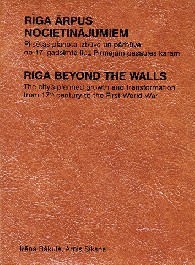|
|
| The City - a Live Being or a Construction Pēteris Bankovskis, art critic
Irēna Bākule, Arnis Siksna. Riga Beyond the Walls (Rīga: Neputns, 2009)
| |
| A qualified architect and expert in monument protection, Irēna Bākule, and a Doctor of Architecture from Australia, Arnis Siksna, have produced a book Riga Beyond the Walls: The city's planned growth and transformation from the 17th century to the First World War. It has been published by Neputns as a "non-traditional" softcover edition, as is often the case with books for professional architects elsewhere in the world, but unprecedented in this country (graphic designers Zigmunds Lapsa un Sandijs Ruļuks). The book has a convenient layout. The Latvian text by Bākule has been printed in black, the English text by Siksna - in blue. | |
 Irēna Bākule, Arnis Siksna. Riga Beyond the Walls. The city's planned growth and transformation from the 17th century to the First World War. Rīga: Neputns, 2009. 248 pages, illustrated. In Latvian and English | |
| The book, using maps, plans and maps/plans, archive materials and literature, follows the formation of the street network, of neighbourhood blocks and their parcellation (subdivision into individual plots) in the part of Riga between the Old Town and the arc of the railway line. Analysis has been made of normative regulatory guidelines and documents issued by various authorities under different historical conditions stipulating what, how and why should something be built beyond the walls of the fortified mediaeval city. These concepts and documents have been presented together with the actual building practice, as it was and such as the contemporary researcher has been able to determine from documents and in the field.
The book can be read at least two ways. One way - if you are an expert on urban construction history or have a particular interest in this subject, you can do a detailed research of the sources used by the authors and how these have been interpreted, how various city building concepts developed and their relationship to the history of fortification and warfare. Another way - while keeping all the above in mind as a background, to regard the contents of the book as a neverending story of the "organic" development and transformation of spatial structures. If we perceive the city - manmade pseudo-nature - as yet another landscape, with streets and boulevards in the place of valleys and rivers, and groups and rows of houses replacing mountains and hills. This landscape has undergone its own ice ages, when the development of suburbs was restricted or existing housing was destroyed. And the subsequent thaws or warming, when the conditions and opportunities were favourable for feverish construction activity. As in nature, urban streams and glaciers also have their own source. The authors of the book, following a currently prevailing trend, seek and find these sources in the West, occasionally reminding the reader that one Russian civil servant or another who had taken part in the planning of the city of Riga had his homeland, heart and sphere of influence somewhere in Western Europe. Understandably, when examining the formation and structural evolution of the city as a natural phenomenon, one is tempted to give preference to elemental forces, with the engineers and architects, officials and document signatories being moved to one side as impediments, however obligatory they may have been. However in doing so, a third option for reading the book emerges - to try to discern in the panorama of Riga city development the age old question about the role of personalities in history. And there is one other possibility: not to read the text at all, but to immerse oneself in viewing the numerous illustrations, and through them to follow the history of building in various locations in Riga. /Translator into English: Sarmīte Lietuviete/ | |
| go back | |







